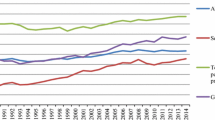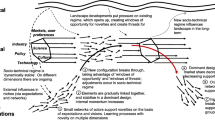Abstract
In the discussion on innovations for sustainable development, radical innovations are frequently called for in order to transform society into a system perceived as sustainable successfully. The reason for this is the greater environmental efficiency of these innovations. This hypothesis is, however, not supported by empirical evidence. Given the background of a global increase in coal-fired power plants and the consequent environmental impacts to be expected, the hypothesis that radical innovations are superior to incremental innovations and will thus be introduced to the market is reviewed on the basis of fossil fuel power plants. In this paper we examine the diffusion of incremental and radical innovations in the field of power plants and the basic obstacles confronting these innovations. For example, we compare Pressurized Pulverized Coal Combustion (PPCC) as a radical innovation and supercritical coal-fired power plants as an incremental innovation. PPCC failed due to technological uncertainty. We show in an ex-post analysis of the German R&D portfolio for power plants in the past three decades from an environmental viewpoint that, for radically innovative technologies, it was difficult to be accepted by possible investors. The future potential of radical innovations in the field of power plant technology is to be regarded as relatively low, especially due to technological uncertainty, market uncertainty and sunk costs. The conclusion for future R&D work in the sector of large-scale power plants is that an innovation is more likely to succeed if it follows established technological trajectories. In the context of energy market liberalization, hardly any radical innovations are expected in the technology of power plants. The findings of this paper may also be helpful to evaluate risks or probabilities of success of technologies being developed currently. We discuss for example the technological trajectories currently favored in CO2 capture.





Similar content being viewed by others
References
Astebro T (2004) Sunk costs and the depth and probability of technology adoption. J Ind Econ LII(3):381–399
ATLAS (1997) Main report—energy technology information base 1980-2010. European Commission, DG XVII (Energy). THERMIE Program. Brussels
Bakker G (2005) The decline and fall of the European film industry: sunk costs, market size, and market structure, 1890–1927. Econ Hist Rev LVIII 2(2005):310–351
Berkhout F (2005) Technological regimes, environmental performance and innovation systems: tracing the links. In: Weber M, Hemmelskamp J (eds) Towards environmental innovation systems. Springer, Berlin
Berkhout F, Smith A, Stirling A (2004) Socio-technical regimes and tranistion contexts. In: Elzen B, Geels FW, Green K (eds) System innovation and the transition to sustainability—theory, evidence and policy. Edward Elgar, Cheltenham
Bohn D (2008) Future developments for CO2-free power plants technologies with integrated gas turbines. VGB PowerTech 7:24–30
Carillo-Hermosilla J (2006) A policy approach to the environmental impacts of tchnological lock-in. Ecol Econ 58:717–742
Commission of the European Communities (2007) Communication from the Commission of the Commission to the European Council and the European Parliament - an energy policy for Europe. Brussels
COORETEC (2003) Forschungs- und Entwicklungskonzept für emissionsarme fossil befeuerte Kraftwerke, BMWA Dokumentation Nr. 527
David PA (1985) Clio and the economics of QWERTY. Am Econ Rev Int Polit Econ 75:332–337
Defeuilley C, Furtado AC (2004) Impacts de l’ouverture à la conucurrence sur la R&D dans le secteur électrique. Ann Public Coop Econ 71(1):5–28
Dosi G (1988) Sources, procedures, and microeconomic effects of innovation. J Econ Lit XXVI:1120–1171
Faber A, Frenken K (2008) Models in evolutionary economics and environmental policy: towards an evolutionary environmental economics. Technol Forecast Soc Change 76:462–470. doi:10.1016/j.t4echnfore.2008.04.009
Freemann C (1992) The economics of hope. London, New York
Garcia R, Calantone R (2002) A critical look at technological innovation ty-pology and innovationess terminology: a literature review. J Prod Innov Manag 2002:110–132
Geels FW (2004) Understanding system innovations: a critical literature review and a conceptual synthesis. In: Elzen B, Geels FW, Green K (eds) System innovation and the transition to sustainability - theory, evidence and policy. Edward Elgar, Cheltenham
Geels FW, Elzen B, Green K (2004) General introduction: system innovation and transitions to sustainability. In: Elzen B, Geels FW, Green K (eds) System innovation and the transition to sustainability - theory, evidence and policy. Edward Elgar, Cheltenham
Held H, Krieger E, Lessmann K, Edenhofer O (2009) Efficient climate policies under technology and climate uncertainty. Energy Econ 31:550–561
IEA (International Energy Agency) (2008a) CO2 capture and storage: a key carbon abatement option. OECD/IEA, Paris
IEA (International Energy Agency) (2008b) World energy outlook, (IEA), I. E. A. IEA/OECD, Paris
IPCC (International Panel on Climate Change) (2005) IPCC special report on carbon dioxide capture and storage. Working group III of the intergovernmental panel on climate change. Cambridge University Press, New York
Jacquier-Roux V, Bourgeois B (2002) New network of technological creation in energy industries: reassessment of the roles of equipment suppliers and operators. Technol Anal Strateg Manag 14(4):399–417
Jäger G (2005) Großversuch in Scholven. BWK 57:36–37
Jamasb T, Pollitt M (2008) Liberalisation and R&D in network industries: the case of the electricity industry. Res Policy 37:995–1008
Jensen SG, Meibom P (2008) Investments in liberalised power markets—gas turbine investment opoortunities in the Nordic power system. Electr Power Energy Syst 30:113–124
Kather A, Rafailidis S, Hermsdorf C, Klostermann M, Maschmann A, Mieske K, Oexmann J, Pfaff I, Rohloff K, Wilken J (2008) Research and development needs for clean coal deployment. IEA Clean Coal Centre, Report CCC/130, London
Kemp R (1997) Environmental policy and technical change. Edward Elgar, Cheltenham, Brookfield
Kemp R (2007) An example of “managed transition”: the transformation of the waste management subsystem in the Netherlands (1960-2000). In: Lehmann-Waffenschmidt M (ed) Innovations towards sustainability - conditions and consequences. Physica, Heidelberg
Kemp R, Arundel A (1998) Survey indicators for environmental innovation, IDEA, Indicators and Data for European Analysis) paper series 8/1998
Kemp R, Rotmanns J (2005) The management of the co-evolution of technical, environmental and social systems. In: Weber M, Hemmelskamp J (eds) Towards environmental innovation systems. Springer, Berlin
Klemmer P, Lehr U, Löbbe K (1999) Umweltinnovationen: Anreize und Hemmnisse, Berlin
Lezuo A, Riedle K, Wittchow E (1989) Entwicklungstendenzen steinkohlebefeuerter Kraftwerke. BWK 41:13–21
Lutz C, Meyer B, Nathani C, Schleich J (2005) Endogenous technological change and emissions: the case of the German steel industry. Energy Policy 33:1143–1154
Manez JA, Rochina-Barrachina ME, Sanchis A, Sanchiz JA (2009) The role of sunk costs in the decision to invest in R&D. J Ind Econ LVII(4):712–735
Martin H (1988) Steigerung des prozesswirkungsgrades kohlegefeuerter Kraftwerke. VGB Kraftwerkstechnik 68:219–225
OECD (Organisation for Economic Cooperation and Development) (2005) Guidelines for Collecting and Interpreting Technological Innovation Data – Oslo Manual, The Measurement of Scientific and Technical Activities Series, Paris
Otto VM, Reilly J (2008) Directed technical change and the adoption of CO2 abatement technology: the case of CO2 capture and storage. Energy Econ 30:2879–2898
Pavitt K (1984) Sectoral patterns of technical change: towards a taxanomy and a theory. Res Policy 13(3):343–373
Pindyck RS (2000) Irreversibilities and the timing of environmental policy. Resour Energy Econ 22:233–259
Pruschek R, Renz U, Weber E (1990) Kohlekraftwerke der Zukunft. Stand und Entwicklung, Erprobung und Planung neuer Kohlekraftwerks-Technologien, Studie im Auftrag des Ministers für Wirtschaft, Mittelstand und Technologie des Landes NRW, Düsseldorf
Reinelt PS, Keith DW (2007) Carbon capture retrofits and the cost of regulatory uncertainty. Energy J 28(4):101–127
Rennings K (2000) Redefining innovation - eco-innovation research and the contribution from ecological economics. Ecol Econ 2000:319–332
Rennings K, Zwick T (2002) The employment impact of cleaner production on the firm level - empirical evidence from a survey in five European countries. International Journal of Innovation Management (IJIM), Special Issue on. Manag Innov Environ Sustain 6:319–342
Rennings K, Kemp R, Bartolomeo M, Hemmelskamp J, Hitchens D (2004) Blueprints for an integration of science, technology and environmental policy. ZEW, Mannheim
Roques FA (2008) Technology choices for new entrants in liberaliszed markets: the value of operating flexibility and contractual arrangements. Util Policy 16:245–253
Rose NL, Joskow PL (1990) The diffusion of new technologies: evidence from the electric utility industry. RAND J Econ 21(3):354–373
Rosenberg N (1972) Factors affecting the diffusion of technology. Explor Econom Hist 10:3–33
Sartorius C, Zundel S (eds) (2005) Time strategies, innovation and environmental policy. Cheltenham
SRU (German Advisory Council on the Environment) (2008) Umweltschutz im Zeichen des des Klimawandels, Berlin
Stiglitz JE (1987) Technological change, sunk costs and competition. Brookings Pap Econ Act 3:883–937
Vellinga P (2004) Foreword. In: Elzen B, Geels FW, Green K (eds) System innovation and the transition to sustainability—theory, evidence and policy. Edward Elgar, Cheltenham
Acknowledgements
The authors would like to express their appreciation for the support in the context of the project “Decision criteria towards efficiency of strategic R&D subsidies—innovation–economic principles and applications to new energy technologies”, which was funded by the support program EDUARD (Energie-Daten und Analyse R&D—Energy Data and Analysis R&D) initiated by the German Federal Ministry of Economics and Technology (BMWi). Thanks for productive comments to our colleagues Andres Löschel and Sascha Rexhäuser, to Joachim Schleich from the Fraunhofer ISI Institute, and to anonymous referees. We would like to thank Anne-Kathrin Koch for a language check.
Author information
Authors and Affiliations
Corresponding author
Rights and permissions
About this article
Cite this article
Rennings, K., Markewitz, P. & Vögele, S. How clean is clean? Incremental versus radical technological change in coal-fired power plants. J Evol Econ 23, 331–355 (2013). https://doi.org/10.1007/s00191-010-0198-9
Published:
Issue Date:
DOI: https://doi.org/10.1007/s00191-010-0198-9




